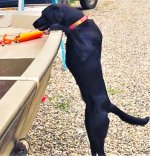Weimdogman
Well-known member
My friend has 2 labs and after hunting with my buddies vdds and my weims informed us that he told his better half "when the old dog can't hunt anymore we are getting a versatile". He says it's just too simple not to.
my buddies vdds
There will still be plenty of backyard breeders.Oh no how will the labrador breed survive without your buddy!
After getting pointing breeds. I don't think I can ever go back to flushers. My family only had labs before that and don't think it's because labs are bad in any way, they just aren't the same as hunting behind your own pointer. If I hunted waterfowl, I possibly would lean the other way, but I don't and for upland game I put on miles and I like a dog who does the same. (I know some labs can do that, but that doesn't mean you can pick and lab and it'll do the same).
Yeah I agree. I've talked with a lot of guys that have versatile dogs at various NAVHDA events and a lot of them used to run labs and they say they'd never go back to a lab after having a versatile breed. Again, not that labs are bad dogs by any stretch, they're just different compared to a versatile dog.After getting pointing breeds. I don't think I can ever go back to flushers. My family only had labs before that and don't think it's because labs are bad in any way, they just aren't the same as hunting behind your own pointer. If I hunted waterfowl, I possibly would lean the other way, but I don't and for upland game I put on miles and I like a dog who does the same. (I know some labs can do that, but that doesn't mean you can pick and lab and it'll do the same).


Are you saying you wistle sit them from 200 yards away when they get birdied? If so that's impressive.I started with English Setters and a Visla.
They were excellent on quail and huns.
There were a couple things I did not like:
1) if the dog went on point in a sea of cattails, as a solo hunter I would have difficulty getting a flush and shot
2) if the birds (rock ptarmigan or chukars) walked away from a point it was not rewarding the dog for the point
3) if the dog was birdy, but not yet on point, I would not shoot because that is rewarding the flush, not the point
and late season sharptails tend to flush.
In open country in Montana, I hunt my labs like pointers...they are out about 200 yards.
I follow the lab until she gets birdy, then whistle sit and move around to where I anticipate the flush.
Works well for me on ptarmigan in Alaska, huns and sharptails in Montana.
My labs are well conditioned and built for upland hunting.
View attachment 7815
View attachment 7816
This is the first time I think I've ever seen someone claim a versatile dog was too slow hahaI have 2 labs and a springer and after hunting with my buddies GSPs, setters, vislas, and griffons, I will not be getting a versatile dog until I'm too old to keep up with a flusher. It's just too boring. At some point, I understand you just get too slow to actually hunt, and I'm happy there's some breeds out there so you can still shoot birds after that happens, but for now I'm still able-bodied and like a bit of excitement. Plus, if you hunt pheasants in the midwest, a flushing dog just puts more birds in the bag.
